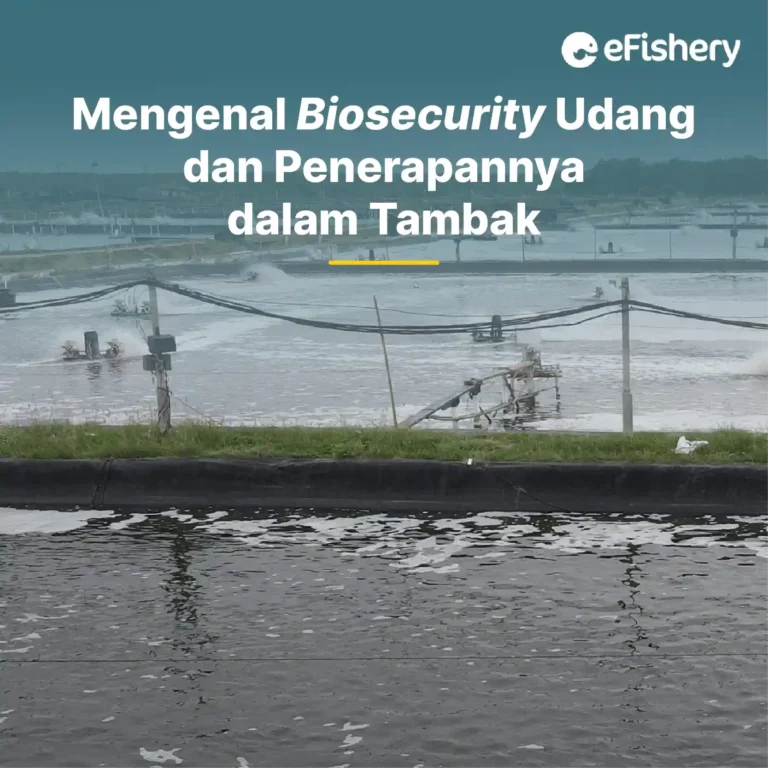Artikel Ini Telah Direview Oleh:

Nabilla Anggi
Magister Budidaya Perairan
Biosecurity Shrimp is one of the right preventive measures to overcome aquaculture problems. This is caused by the many diseases that lurk in shrimp ponds and are ready to infect your shrimp.
These diseases arise due to a bad environment or an infection/disease from the host. Shrimp infected with the disease will experience stress, decreased appetite, and even death. That's why biosecurity Shrimp is very important for your pond.
Then, what is it biosecurity shrimp? Check out the full explanation here!
What's that Biosecurity Shrimp?
Biosecurity in shrimp farming is a set of rules applied to minimize the risk of disease transmission in shrimp ponds. Disease transmission can come from anywhere. Diseases caused by viruses have a wide host range, including various aquatic invertebrates such as crabs, worms polychaetes, copepods, microalgae, rotifers, and their dormant eggs.
Deployment Benefits Biosecurity Shrimp
Following are the various benefits of biosecurity in shrimp:
- Minimize the risk of spreading disease
- Efficient use of feed, time, and energy
- Maximizing shrimp yields
- Detect signs of disease early
- Reducing the cost of losses caused by disease
Implementation Steps Biosecurity in Shrimp Ponds
Biosecurity implementation steps in shrimp ponds are as follows:
- Do not use the same tool for different pools. Use 1 tool for 1 pool. For example, if you regularly use secchi disk, try to have each pool secchi disk each. If a tool needs to be used for all pools, such as a DO meter, then you need to sanitize it first before using the tool for different pools.
- Make sure the fry that will be stocked are SPF certified (Specific Pathogen Free) or shrimp fry have been proven to be free from pathogens or other shrimp diseases.
- Before and after entering the pond area, pond personnel must clean themselves with soap and disinfectant. For example, when stocking fry or siphoning, employees must rinse their bodies with water containing a disinfectant (which is harmless to shrimp) and not go in and out or move around the pond during the process.
- Sterilization of pond equipment before use. An example is dipping nets in a disinfectant solution (which is harmless to shrimp) before using them to catch shrimp. If you use a solution that is harmful to shrimp, you can rinse the nets using clean water before using the tool again.
- Perform pond water treatments properly and correctly to kill pathogens in the water. An example is by adding chlorine to the water in the reservoir before the water is channeled into the plot.
- Clean the water reservoir (tandon) from mud, moss, and other impurities.
- Use probiotics to suppress the growth of disease-causing bacteria.
- Do a water test by sending a water sample to the nearest laboratory to check whether the pond water is contaminated with disease or not.
- Limit the access of guests and vehicles entering the pond area. This is done to anticipate the spread of diseases that could have been carried.
- Carry out solid and liquid waste handling strictly before being discharged into the waters. Shrimp cultivation waste can be detrimental to ponds and the surrounding environment.
- Make sure no pests enter the cultivation environment, such as birds, goats, cats, dogs and other animals that have a risk of carrying disease. For handling birds can use bird scaring line.
Learn Cultivation Directly from Practitioners in eFarm's Cultivation Learning Tool!
Need Help Regarding Shrimp Cultivation Business?
Fill in your personal data in the following form. Our team will immediately contact you via the number cellphone attached. Make sure the data entered is correct.
You want to know more about biosecurity through examples in the field? You can get it through features Learn Cultivation in eFarm. One of the senior farmers in Lampung has shared his years of farming experience and how he implemented the strategy biosecurity right in the pond.
eFarm is an application that provides various solutions for farmers regarding problems in shrimp farming. eFarm have features Learn Cultivation which contains videos about shrimp farming, explained directly by experienced shrimp farming experts and practitioners. You can access the videos in this feature for free!
So, let's get information about shrimp farming directly from the feature Learn Cultivation in app eFarm! Have the app now!

Nabilla Anggi - Magister Budidaya Perairan
Nabilla merupakan lulusan sarjana dan magister budidaya perairan serta memiliki pengalaman di dunia perikanan baik hatchery maupun pembesaran
Questions Regarding Shrimp Biosecurity
Biosecurity in shrimp farming is a set of rules applied to minimize the risk of disease transmission in shrimp ponds.
Biosecurity in shrimp is useful for minimizing the risk of disease spread, efficient use of feed, time and energy, mmaximizing shrimp yields, detecting signs of disease early, and reducing the cost of losses caused by disease
- Ariadi, H., TY Mardiana and Linayati. 2022. Application of Biosecurity Application in Shrimp Cultivation Activities at PT. Manunggal Setia Makmur, Probolinggo Regency. Community Journal: Community Service Journal. 4 (2):167-170.
- Desrina, AHC Haditomo and SB Prayitno. 2011. Survey on the Presence of White Spot Syndrome (WSS) Virus on Polychaeta Worms in Shrimp Ponds: A Case Study in Kendal. R&D Journal. 9(2): 130-140.
